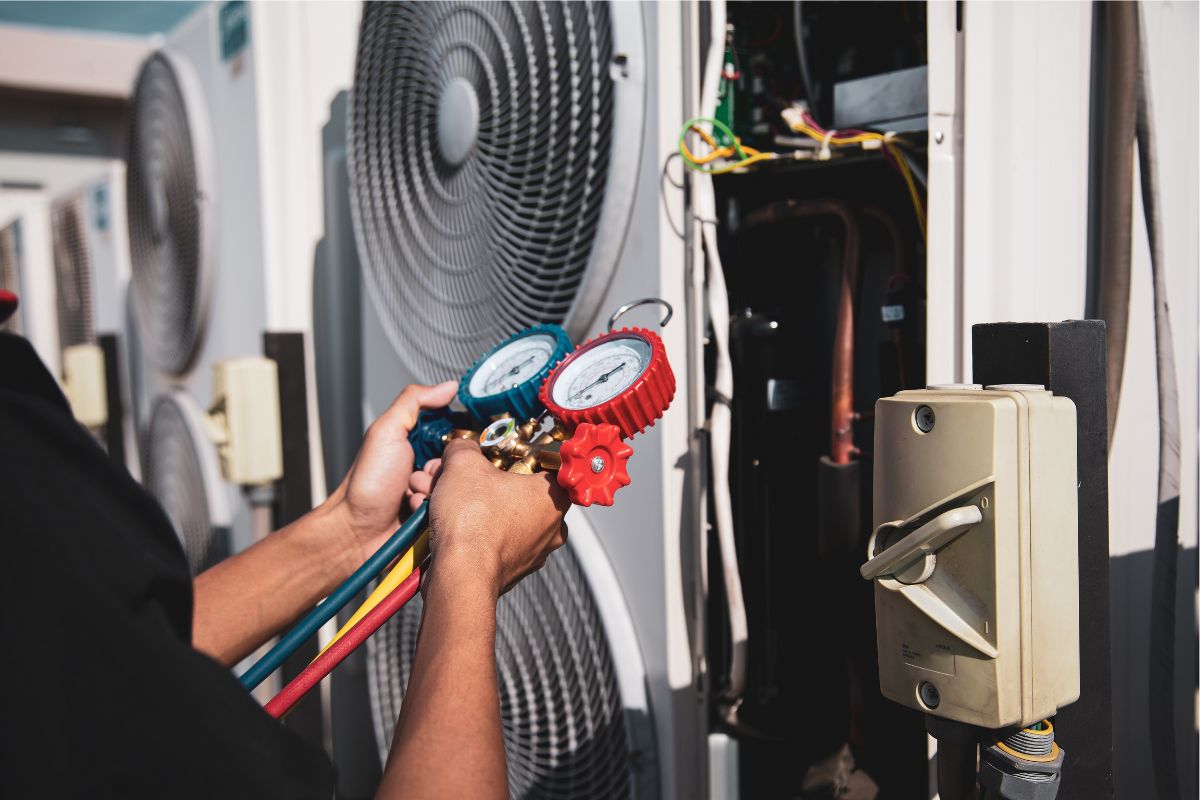This image captured over New York City on October 2, 1999, is a false color composite combining surface temperature and vegetation abundance information. Red indicates surface temperature, green indicates vegetation abundance, and blue indicates visible brightness. Red and pink areas are characterized by higher surface temperatures and lower vegetation abundances. Green and yellow areas are characterized by higher vegetation abundances and lower surface temperatures. Blue and black areas have lower surface temperatures and little or no vegetation. (Image courtesy of Chris Small, Lamont-Doherty Earth Observatory, Columbia University)
Yes, it is hotter in the city, especially at night. Why is this? It’s called the Urban Heat Island Effect and it means that urban areas heat up at more than twice the rate as rural and suburban areas. The high density of population, traffic, concrete, tarmac and carbon dioxide add up to an increased heat rate and a radiant capture effect. At night, this captured heat is radiated back from these surfaces as the earth attempts to cool down and can sometimes lead to a more than 20 degree difference between cities and suburban/rural areas. I know that it will usually be at least 10 degrees cooler at my north shore Long Island home than it will be in Manhattan only 20 miles to the west. This is also partially the reason why the New York City ASHRAE cooling design temperature is 96 degrees while the Long Island design temperature is only 89 degrees. The Heat Island Effect (HIE) is nothing new, the EPA has been studying it for years. However, the build up of greenhouse gases as the result of global warming and the reverse migration back to cities has accelerated the effect and increased the ratio differential between the city and the ‘burbs. Just last year, National Public Radio spotlighted the HIE in this story (see https://www.npr.org/2012/09/04/160393303/as-temps-rise-cities-combat-heat-island-effect). Of course, every cloud has it’s silver lining and the one positive effect of the HIE is that trees and flora in urban areas actually get a growth benefit because of increased photosynthesis due to the warmer evenings and increased carbon dioxide. In fact, a Cornell study shows that a red oak tree grows eight times faster in Central Park due to the HIE! (See https://inhabitat.com/nyc/study-shows-red-oaks-grow-8-times-faster-in-central-park-due-to-urban-heat-island-effect/cornell-study-of-urban-tree-growth-1/). Even NASA has been studying the effect of HIE from satellite imagery. So what’s the answer to this dilemma? Well, it certainly isn’t to increase the capacity of your air conditioning unit if you live in the city because that will exacerbate the problem. The real answer is to plant more trees. Trees and other vegetation help alleviate the urban heat island effect by providing shade, intercepting solar energy, cooling the air, and reducing air pollution. New York City and all urban areas need more green space and less building in the balance and that is what some municipalities are having the courage to recognize. Dale Quattrochi, a senior research scientist at the Marshall Space Flight Center, studied the urban heat island effect in Atlanta. Quattrochi recognized that “when trees absorb sunlight, they don’t heat up like urban materials do. In fact, trees transform solar energy into cool air through a process called evapotranspiration. Trees transpire, or release, water through pores in their leaves, and sunlight helps evaporate this water from the leaf surface. In other words, trees “sweat” to cool off, just like people do. Trees also improve air quality by absorbing air pollutants such as sulfur dioxide and carbon monoxide. But not just any tree will do. Trees like oak and sycamore emit higher amounts of biogenic volatile organic compounds (BVOCs). BVOCs are naturally occurring pollutants that contribute to the development of ground-level ozone. Planting trees such as maple and elm, which are low BVOC emitters, can improve a city’s air quality more effectively than high BVOC emitting trees.” Unfortunately, New York City and Long Island lost tens of thousands of trees during Hurricane Sandy and this will only help to increase the HIE and the heat differential.
So, to escape the summer heat in the city, head to the park or the country or, more importantly, join your urban green space advocacy group and plant oak trees!
Blog
Yes, It Is Summer in the City and It Is Hotter – The Heat Island Effect

Other Blogs
June 26, 2025 |
4 min read
May 22, 2025 |
4 min read


